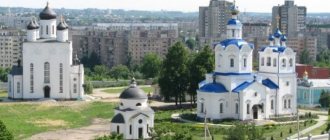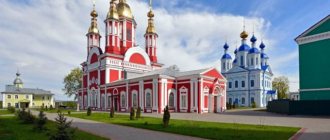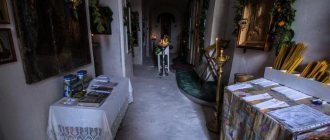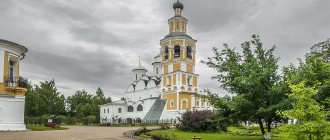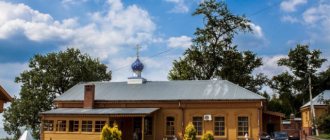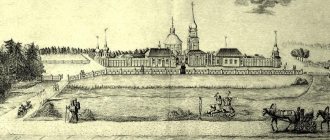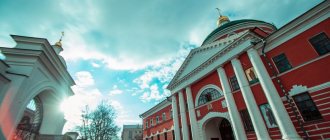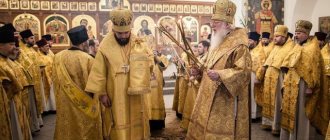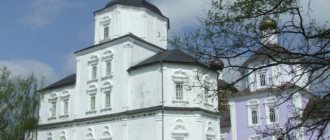| Antoniev-Dymsky Monastery. Photo ok. beginning XXI century |
Antoniev-Dymsky
[1]
monastery in the name of the All-Holy Trinity
of the Tikhvin diocese
- Address: Russia, 187613, Leningrad region, Boksitogorsky district, Bolshedvorskoe village, Krasny Bronevik village, Galichno village
- Tel.
- Directions: from St. Petersburg by bus from the bus station on the Obvodny Canal embankment in the direction of Boksitogorsk or Pikalevo, stop. “Galichino”, then 3 km on foot
- On the map: Yandex.Map, Google map
Located 15 km southeast of Tikhvin and 20 kilometers from Boksitogorsk, on a hill near Lake Dymskoye.
| St. Anthony Dymsky. In the background is the Antoniev-Dymsky Monastery he founded. Icon con. XVII century (MIIRK) |
The first centuries of the monastery's history
One of the oldest monasteries in North-West Russia, the monastery was probably founded in the first half of the 13th century [2] by the Monk Anthony of Dymsky, who settled in a secluded place on the shore of Lake Dymsky, dug out a cave, set up a cell and began to struggle in fasting and prayer. When the brethren gathered, they built a two-story wooden church in the name of St. Anthony the Great [3]. Soon, “for the common repose of the brethren,” another church was built, “warm with a meal,” in honor of the Nativity of John the Baptist. The charter for the creation of the monastery was granted by the blessed prince Alexander Yaroslavich Nevsky [4], in connection with his miraculous healing through the prayers of St. Anthony [5]. Upon the repose of Saint Anthony, his relics were buried in the church he created.
In the 14th century [6] the incorruptible relics of the venerable founder were found in the monastery. It was probably on the day of the discovery of the relics that the celebration of the memory of St. Anthony was established on January 17.
In 1409, the monastery was ravaged and burned by the Tatars of Edigei, but before the destruction the brethren again buried the relics (“let them not be desecrated by the enemies”), and all the church utensils, bells and shrines were lowered to the bottom of Lake Dymskoye. Then the monastery was restored; at the end of the 16th century, the inhabitants of the devastated Valaam monastery found refuge here, bringing with them the Valaam Rule. But in 1611 the monastery was destroyed again - now by the Swedes Delagardi [7].
Thanks to the donations of Tsar Mikhail Feodorovich, in 1626 the “monastery on Dymy” was renewed and the inhabitants of the Valaam monastery, destroyed by the Swedes, were resettled there. In 1655-1656, through the efforts of the builder monk Philaret, a cathedral was built in the monastery in the name of St. Anthony the Great with chapels in the name of St. Nicholas the Wonderworker and in honor of the Kazan Icon of the Mother of God. Consecrated on January 17, 1656, the cathedral became the first stone church of the monastery.
In 1687, the monastery burned down, but was then rebuilt. In 1690, the monastery was assigned to the Novgorod St. Sophia Cathedral. It is also listed as such in the charter of Tsars Ivan Alekseevich and Peter Alekseevich dated June 21, 1692.
| Anthony's Dymsky Monastery. Lithograph 1851 |
Synodal period
In 1744, a gilded wooden tomb was built over the place where the relics of the founder of the monastery were hidden by the St. Petersburg merchant Kalitin, who was healed by the Monk Anthony from a long serious illness.
Until 1764, the Antoniev-Dymsky Monastery owned 120 acres of land, and 111 peasants were assigned to it. During the secularization reform of that year, the monastery was abolished; clergy of the Novgorod diocese lived in its premises. The cathedral church became a parish church and white priests served there for 30 years.
At the end of the 18th century, in the former monastery, Father Abraham Ksenifontov built a new wooden church in honor of the Nativity of John the Baptist, consecrated on June 23, 1783 by Archimandrite Euthymius of the Tikhvin Great Monastery. In the early 1790s, Father Abraham began “finishing” the upper church in the cathedral in the name of the Life-Giving Trinity.
On September 1, 1794, at the request of Archimandrite Ignatius of the Tikhvin Great Monastery, by decree of Metropolitan Gabriel of Novgorod and St. Petersburg, the monastery was restored as a third-class dormitory, and residents of the Tikhvin Monastery, numbering about 30 people, were transferred to it. The monastery began to be managed by builders. The 20-point charter of the revived monastery was drawn up by Metropolitan Gabriel himself, sending it on October 11, 1795. In addition to annual maintenance, the monastery also used a lake, arable land, vegetable gardens, meadow land and a firewood forest. In total, the monastery's income did not exceed 110 rubles per year. The revival of the monastery was supported by Emperor Pavel Petrovich, who on April 9, 1799 donated 2,000 pine trees from the treasury to repair the monastery.
In February 1806, abbot Gerasim (Gaidukov) undertook reconstruction, and in 1840, repair of the monastery Kazan Cathedral, which was reconsecrated in the name of the Holy Trinity. In 1839, under Abbot Amphilochia, the monastery was surrounded by a stone fence with four towers, the Holy Gates and a chapel. In 1840, under Abbot Ilaria, a one-story fraternal building was built, in 1846 - a two-story abbot's building with a fraternal refectory, kitchen and prosphora, in 1849 - a two-story pilgrim building, and in 1850 - utility buildings, glaciers, and a kvass brewery. Thanks to private donations, as well as a gift from the Optina Monastery, by the middle of the 19th century, the monastery had accumulated a small library (about 300 books). The archives of the monastery, according to the inventory of the 1860s, have been preserved only since 1794. In 1867, a two-story building of a hospice house was built.
By the end of the 19th century, the monastery still had two churches - the Trinity Cathedral and the Church of the Baptist. There was a parish school at the monastery, where children from the surrounding villages studied. The income was contributed by the annual 4-day St. Anthony's Fair, which took place in celebration of the day of memory of St. John the Baptist and the repose of St. Anthony of Dymsky. On this day, June 24, after the Divine Liturgy, a religious procession was held from the monastery to Lake Dymskoye.
Destruction during the Soviet years
The penultimate abbot of the monastery, Methodius, according to the report of the dean, Archimandrite Anthony (Demyansky), “turned against himself the surrounding population, which threatened with arson” [8]. After 1919, the monastery was closed and the brethren were evicted. For decades, local residents have been telling the story of how an armored car was sent from Tikhvin, from which the revolutionaries announced the closure of the monastery, perpetuating their “feat” by renaming this place to the village of Krasny Bronevik. According to the stories of residents of surrounding villages, after the closure of the monastery, one of its inhabitants, Hieromonk Job, hid in nearby villages, secretly performing baptisms and funeral services. In 1921, the county social security service placed a “Shelter for the crippled and the elderly” in the monastery premises. In 1929, a brick production commune with the same name, “Red Armored Car,” was formed in the former monastery. However, “production” consisted of dismantling the monastery walls and towers into bricks for sale. As a result of the “brick production”, almost all the monastery buildings were gradually dismantled. In the 1920s, the Church of the Nativity of John the Baptist was closed and then destroyed. However, the Trinity Cathedral is mentioned as operating back in 1931 as a parish church - pilgrims from Tikhvin came here when all the churches in the city were closed. At the end of the 1930s, the cathedral was also closed.
After the Great Patriotic War, a school for tractor drivers was organized in the only remaining abbot building and hotel. At the same time, the monastery cemetery was also destroyed. Later, a psychiatric institution was located in the monastery. The main cathedral of the monastery was used as a warehouse, and in 1956-1961 it was dismantled. In recent decades, the remains of the monastery were transferred to the Boksitogorsk Glinozem plant, and a factory sanatorium was located in the former monastery hospice house.
Renaissance
By the beginning of the 1990s, all that remained of the previous buildings of the monastery were the skeleton of the cathedral bell tower, the empty two-story abbot building, the two-story building of the hospice house, the building of the parochial school, and several wooden outbuildings. The beginning of the resumption of the monastery was the installation in the summer of 1994, through the efforts of the parishioners of the Peter and Paul Church in the village of Somina, of a cross on the shore of Lake Dymskoye. On January 30, 1997, representatives of the Glinozem plant handed over the keys to the hospice building - the only building preserved in operational condition - to the inhabitants of the Tikhvin Assumption Great Monastery, and on October 30 of the same year, the Antoniev-Dymsky Monastery was reopened as a registered monastery of the Tikhvin monastery.
Divine services were initially resumed in the house chapel in the former hospice house. In 2000, a new refectory church was built, and restoration of the Trinity Cathedral began. On June 16, 2001, during excavations at the site of the cathedral, the relics of St. Anthony of Dymsky were discovered, first placed in the Assumption Cathedral of the Tikhvin Monastery, and on June 1, 2008, returned to the reviving Dymsky monastery.
By a synodal decision of October 6, 2008, the monastery was reopened as an independent one. The first bishop's service known in the history of the monastery was performed there by Bishop of Gatchina Ambrose (Ermakov) on March 14 and 15, 2009 [9]. On the 10th anniversary of the discovery of the relics of the founder of the monastery, a stone chapel in the name of St. Anthony of Dym was built opposite the monastery lake, and on July 7, 2011, it was consecrated. In 2012, a monastery courtyard was opened at the St. Petersburg Church of the Intercession on Borovaya. Since by 2013 the population of the village of Krasny Bronevik consisted almost entirely of monks and people who work for the monastery, the question arose of renaming the settlement, perpetuating the “dispersal” of the monastery of the early 20th century [8].
| Temple of Varlaam of Khutyn Antony-Dymsky Monastery. Photo ok. beginning XXI century |
Temples, architecture
Varlaamo-Khutyn Temple
The church in the name of St. Varlaam Khutynsky at the refectory was converted from a boiler room building. The minor consecration of the temple took place in 2001.
Anthony's-Dymskaya Chapel
A stone chapel in the name of St. Anthony of Dymsky was built on the shore of Lake Dymsky in 2011 and consecrated on July 7 of that year.
Lost
Anthony's Temple
The original churches of the monastery were erected under the Venerable Anthony of Dymsky in the 13th century. The first was the two-story wooden church of St. Anthony the Great. The upper church of this temple was consecrated either in the name of St. Nicholas the Wonderworker (according to the early edition of the life of St. Anthony of Dymsky), or in honor of the Intercession of the Mother of God (according to the later edition). The time of the loss of this temple is unknown.
The first stone cathedral of the monastery, built in 1655-1656, was also dedicated to St. Anthony the Great, but was later reconsecrated in honor of the Kazan Icon of the Mother of God, and then in the name of the All-Holy Trinity.
Church of the Nativity of John the Baptist
Soon after the establishment of the monastery, under the Venerable Anthony of Dymsky in the 13th century, “for the common repose of the brethren,” the second church of the monastery was built, “warm with a meal,” in honor of the Nativity of John the Baptist. The time of the loss of this temple is unknown.
At the end of the 18th century, a new wooden church was built in the monastery, which was abolished at that time, in honor of the Nativity of John the Baptist, consecrated on June 23, 1783 by Archimandrite Euthymius of the Tikhvin Great Monastery. This church was closed in the 1920s and then destroyed.
Trinity (formerly Antonievsky, Kazan) Cathedral
The monastery cathedral was erected in 1655-1656 through the efforts of the builder, monk Philaret. The cathedral became the first stone building in the monastery. Initially, the cathedral was consecrated in the name of St. Anthony the Great with chapels in the name of St. Nicholas the Wonderworker and in honor of the Kazan Icon of the Mother of God. Then the Kazan throne became the main one, and the chapel of Anthony the Great was built over the tomb of St. Anthony of Dymsky).
As a result of reconstruction in February 1806 and repairs in 1840, the second floor of the cathedral was built with the main altar consecrated in the name of the Holy Trinity (on the right, consecrated on February 15, 1806), and with the chapel of St. Anthony of Dymsky (on the left, consecrated on February 24, 1806). The first tier of the cathedral now consisted of the chapels of the Kazan Icon of the Mother of God (consecrated on August 28, 1849) and St. Anthony the Great (consecrated on July 10, 1850). As a result, the cathedral became five-domed and four-altared with a two-tier bell tower. It was closed at the end of the 1930s, and dismantled in 1956-1961. Since the early 2000s, restoration work has been carried out.
Hermitages and farmsteads
- St. Petersburg Compound:
- Intercession Church on Borovaya
- Description
- Pilgrimages (4)
- Trips here (11)
Description of the Anthony-Dymsky Monastery
Antoniyevo-Dymsky Holy Trinity Monastery is a male monastery in the village of Krasny Bronevik, Boksitogorsk district, Leningrad region, 17 kilometers from Tikhvin and 20 kilometers from Boksitogorsk.
The monastery belongs to the St. Petersburg diocese of the Russian Orthodox Church. The rector is Abbot Ignatius (Buzin).
The monastery, according to legend, was founded by St. Anthony around 1243. The official establishment occurred later, with the award of a charter by Grand Duke Alexander Nevsky.
The monk died on June 24, 1273, his body was laid in the church of St. Anthony the Great, built by him, near the choir. In 1370, the relics of the saint were found incorrupt and placed openly in a shrine in the same St. Anthony Church.
In 1409, the monastery was completely destroyed during the invasion of Khan Edigei to the Novgorod lands. The inhabitants of the monastery, seeing the approach of the enemy, sang a prayer service at the shrine with the relics of St. Anthony and hid them under a bushel, placing a stone slab and covering them with earth. Church utensils, bells, chains and the saint’s hat were lowered to the bottom of Lake Dymskoye. Subsequently, shrines were found in its waters.
Since 1585, after the destruction of the Valaam Monastery by the Swedes (in 1578), its monks moved to the “monastery near Ontonya the Great on Dymekh.” Valaam communal traditions were preserved here. In 1618, the Valaam monks were transferred to the Vasilievsky Monastery on Volkhov.
In 1611, the monastery was ravaged by the Swedes. The troops of Jacob Delagardie were unable to take the Tikhvin Assumption Monastery by siege and attacked the Dymskaya monastery. The unfortified monastery was unable to offer resistance, and the brethren dispersed into the surrounding forests. Temples and cells were burned.
In 1626, with the blessing of Patriarch Philaret, Tsar Mikhail Fedorovich ordered the restoration of the “monastery on Dymy.” And during the reign of Alexei Mikhailovich in 1655, through the labors of Abbot Philaret, the first stone church was built in the Dymsky Monastery.
In 1687, the Dymsky Monastery burned down and was then rebuilt.
In the charter of Tsars Ivan Alekseevich and Peter Alekseevich dated June 21, 1692, the monastery was listed as attached to the Novgorod St. Sophia Cathedral.
[edit] Sources, opinions on the early history of the monastery
The source of information about the founding of the monastery is the life of St. Anthony of Dymsky, the earliest surviving edition of which dates back to the end of the 17th century. It was probably compiled in the Anthony-Dymsky Monastery using local legends.
The second edition, a later one, dates back to the end of the 18th and beginning of the 19th centuries and, according to researchers, is a reworking of the earlier edition based on the life of Theodosius of Totemsky.
The first edition names the reasons for the paucity of information about the early history of the monastery: ancient information was not preserved “from the great oblivion and negligence... and from former fires and all sorts of military people’s riots and discoveries, and from those living in the monastery, all kinds of poverty and simplicity.” At the same time, both editions preserve the date of foundation of the monastery - around 1243. A later version reports that the charter for the creation of the monastery was granted by Alexander Nevsky.
Only in the later edition is the events of 1409, 1611 and 1626 mentioned. I.P. Mordvinov considered this news legendary, since there were no indications of events in other sources.
There is a publication of an inventory of the monastery from 1583, as well as a letter from the Novgorod Metropolitan Varlaam dated May 23, 1592 to the Dymsky Monastery to the Valaam elders:
and you, and the cathedral elders, and all the brothers and servants, lived in that monastery at Ontonya the Great on Dymekh, according to the order of the monastery, throughout the monastery life decorously, peacefully and serenely, according to the tradition of the fathers and according to the law of their former Valamsky leaders Sergius and Herman, community life, what is the law and their beginning was laid from ancient times in the Valamsky monastery; and now, according to the same nature, in that monastery on Dymekh, the law was not destroyed, but was fulfilled according to every “decency, and all the brothers and servants lived in harmony, together, with one mind and among themselves in obedience, and did the monastery according to the advice with the council of all the brothers, and without the brotherly council, neither your elder nor servant would have functioned in the monastery, you would have had a community as before, and paid clothes and shoes for brothers and servants, every person in the monastery, would have been given in the old days from the monastery treasury ...
During the secularization of the monastic lands in 1764, the monastery was abolished, and the cathedral church became a parish church. In 1794, Archimandrite Ignatius of the Tikhvin Monastery petitioned Metropolitan Gabriel of St. Petersburg and Novgorod for the restoration of the monastery. By decree of September 1, 1794, the Dymsky Monastery was reopened with a communal charter drawn up by the Metropolitan in his own hand and sent by him on October 11, 1795.
On April 9, 1799, Emperor Paul I donated 2,000 pine trees from the treasury to repair the monastery.
In the 19th century the monastery was renovated. Most of the wooden buildings have been replaced with stone ones. In 1839, through the efforts of Abbot Amphilochius, a stone fence with four towers in the corners and the Holy Gates was erected around the monastery. In 1840, under Abbot Ilaria, a one-story fraternal building was built; in 1846 - a 2-story abbot's building with a fraternal refectory, a kitchen and a prosphora; in 1849 - a 2-story pilgrim building; in 1850 - utility buildings, glaciers, kvass brewery.
There was a parish school at the monastery, where children from the surrounding villages studied.
The monastery was 3-class, received an annual maintenance of 85 rubles 71 kopecks, in total its income did not exceed 110 rubles per year. The monastery also used a lake, arable land, vegetable gardens, meadow land and a firewood forest. Income was contributed by the annual 4-day St. Anthony's Fair, held on the feast day of St. John the Baptist (June 24/July 7).
The number of inhabitants, starting from 30 monks of the Tikhvin Monastery who settled here in 1794, increased to 55 by 1917. The last abbot of the monastery was Abbot Theoktist (Kirillov).
In 1919 the monastery was abolished. According to local residents, an armored car was brought “to disperse the monks.” In memory of that event, the monastery was renamed the settlement “Red Armored Car”.
In 1921, the “Shelter for the Crippled and Elderly” was located in the monastery premises. In 1929, a brick production commune called “Red Armored Car” was formed in the Dymsky Monastery. In essence, her activity consisted of dismantling monastery walls and towers into bricks for sale.
Trinity Cathedral operated until the end of the 1930s as a parish church. At the same time, the monastery cemetery was also destroyed.
After the Great Patriotic War, a school for tractor drivers was organized in the preserved cell building and hotel. Then the buildings became a psychiatric hospital.
In recent decades, the remains of the monastery were transferred to the Boksitogorsk Alumina plant, and a factory sanatorium was located in the former monastery hospice house. The main cathedral of the monastery was used as a warehouse. In 1956-1961 it was finally dismantled.
By the beginning of the 1990s, the following remained of the monastery complex: the skeleton of a four-tiered cathedral bell tower, a two-story cell building (1830s), a two-story building of a hospice house (1867), a parochial school building, and several wooden outbuildings of the monastery.
In 1994, on Dymskoe (Holy) Lake, near the stone on which, according to legend, the Monk Anthony prayed, a 4-meter wooden cross was installed. Its installation was timed to coincide with the 770th anniversary of the repose of St. Anthony (1224-1994) and the 200th anniversary of the 2nd renewal of the monastery in 1794.
On October 30, 1997, the Antoniyevo-Dymsky Monastery was transferred to the Russian Orthodox Church and assigned as a monastery to the Tikhvin Monastery.
In 2000, restoration of the main cathedral of the monastery began, which continues to this day. In 2001, the third discovery of the relics of St. Anthony took place in the monastery. A wooden chapel of St. Anthony was erected on Lake Dymskoye.
On October 6, 2008, the monastery became an independent monastery, and Abbot Ignatius (Buzin) was appointed its rector.
Pilgrimage trips to the Anthony-Dymsky Monastery
- Trip from Moscow to the Anthony-Dymsky Monastery
- Trip from Tikhvin to the Anthony-Dymsky Monastery
- Trip from St. Petersburg to the Anthony-Dymsky Monastery
- Trip from St. Petersburg to the Anthony-Dymsky Monastery
- Trip from St. Petersburg to the Anthony-Dymsky Monastery
- A trip from Krasny Bronevik (Leningrad region) to the Antoniyevo-Dymsky Monastery
- Trip from St. Petersburg to the Anthony-Dymsky Monastery
- Trip from Volgograd to the Antoniyevo-Dymsky Monastery
- Trip from Tikhvin to the Anthony-Dymsky Monastery
- A trip from Krasny Bronevik (Leningrad region) to the Antoniyevo-Dymsky Monastery
- Trip from St. Petersburg to the Anthony-Dymsky Monastery
- Trip from St. Petersburg to the Anthony-Dymsky Monastery
- Trip from Tikhvin to the Anthony-Dymsky Monastery
- Trip from St. Petersburg to the Anthony-Dymsky Monastery
- A trip from Krasny Bronevik (Leningrad region) to the Antoniyevo-Dymsky Monastery
- Trip from St. Petersburg to the Anthony-Dymsky Monastery
- Trip from St. Petersburg to the Anthony-Dymsky Monastery
Abbots
- St. Anthony Dymsky (XIII century)
- …
- Gerasim (Gaidukov) (mentioned February 1806)
- …
- Amphilochius (mentioned 1839) abbot.
- Ilarius (mentioned 1840) abbot.
- …
- Methodius (mentioned 1913)
- Feoktist (Kirillov) (last abbot) abbot.
1919 - 1997 - closure and desecration
Builders of the monastery
- Bartholomew (Kovalyov) (mentioned March 2001)
- Nikita (Petukhov) (2000s) hierodiac.
Abbots of the monastery
- Ignatius (Buzin) (October 6, 2008 - October 23, 2014)
- Adrian (Dementyev) (from October 23, 2014)
Veneration of the Reverend
The main shrine of the monastery is the relics of its founder, St. Antonia. Many pilgrims also strive to visit Dymskoye Lake; there is even a version that the name of the lake comes from the fact that it is covered with the prayers of the monk, as if with incense smoke.
In pre-revolutionary times, visiting people, no matter what the weather or season, plunged into the waters of the lake, believing in their healing power and, by faith, receiving what they asked for. They say that the font itself on the lake was built by a merchant who received healing here.
Now, according to the official website of the monastery, the largest number of pilgrims is for the Feast of Pentecost, as well as for July 7, the day of remembrance of the Prophet John the Baptist and St. Antonia.
Svytyn
- cancer with the relics of St. Anthony Dymsky
- St. iron hat Anthony of Dymsky - in the pre-revolutionary years it was kept next to the wooden gilded shrine of St. Anthony in Trinity Cathedral; weighed more than 3 kg.
- list of the Kazan Icon of the Mother of God - kept in the monastery cathedral, especially revered in the pre-revolutionary years, location after the revolution is unknown
Statistics
- 1794 - during the restoration of the monastery, the inhabitants of the Tikhvin Monastery, numbering approx. 30 people [10]
- shortly before 1917 - 55 inhabitants [11]
- March 2001 - Antoniev-Dymsky Monastery (attached to the monastery of the Tikhvin Dormition Monastery) - 2 inhabitants [10]
Life
The worldly name of the saint has not been preserved. It is only known that he came from a pious Novgorod family ; the names of his parents also did not remain in history. Different sources indicate the year of birth of the ascetic as 1157 or 1206.
Useful materials
Already from his youth, Anthony showed a penchant for monasticism and sought to leave the world with its temptations and temptations. In 1225, Anthony chose the Spassky Monastery in Khutyn for tonsure, and came to Abbot Varlaam, already known for his holiness.
According to some sources, the perspicacious elder, seeing Anthony’s spiritual gifts, tonsured him almost immediately; according to others, about 2 years passed before Anthony’s tonsure. The monk was given a name in honor of St. Anthony the Great.
It is more or less reliably known that the humble, meek Anthony became one of the close students of the abbot , St. Varlaam. Some authors believe that this caused jealousy and envy of the brethren, from which the ascetic had to endure a lot of persecution and insults.
About 10 years after his tonsure, he even had to leave the monastery: Varlaam sent him to Constantinople, to Patriarch Athanasius, on some monastic affairs. However, according to other sources, Anthony was chosen for this work by the brethren for his virtues.
One way or another, Anthony spent 5 whole years in Constantinople and returned to his homeland shortly before the death of his elder, St. Varlaam, in 1243
It was to him that Varlaam entrusted the monastery after his death. But Anthony's abbess did not last even a year. soon left the monastery , which may have been provoked by a new conflict with the brethren, but, of course, corresponded to the ascetic’s desire for a solitary life.
Literature
- [Inventory of Anthony's Dymsky Monastery 1682, 1689], Archive of St. Petersburg FIRI RAS
, f. 132, op. 2, units No. 609. - [Inventory of Anthony's Dymsky Monastery 1583], VOIDR
, 1850, book. 6, p. 89. - John, Hierom., Historical and statistical description of the Dymsky Monastery
, St. Petersburg, 1861. - Pavlovsky A. A., General illustrated guide to monasteries and holy places of the Russian Empire and Mount Athos
, B. m., 1907. - Mordvinov I.P., “Letter to the editor”, Novgorod North
, 1915, No. 33. - Mordvinov I.P., Old Tikhvin and Nagornoye Obonezhye
, Tikhvin, 1925. - Milchik M.I., Varakin E.P., “Iconography of the wooden Anthony Monastery and its graphic reconstruction”, Folk Architecture: Collection.
scientific tr. , Petrozavodsk, 1992, p. 141-154. - Belobrova O. A., “Two editions of the life of Anthony of Dymsky”, TODRL
, 1997, vol. 50, p. 281-292. - Belovolov G., priest, “Reverend Anthony of Dymsky - disciple of Varlaam Khutynsky”, Sofia.
Novgorod , 1998, No. 2, 32-34. - Rumyantseva I., Kudryashev S., Monasteries of the St. Petersburg Diocese
, St. Petersburg, 2000, p. 72-79.
How does Saint Anthony of Dymsky help?
Believers give him their prayers to cope with physical temptations and in any difficulties in life, to get rid of lustful desires, in various diseases, for protection from fire.
Text of the prayer to Anthony Dymsky:
O good shepherd, our mentor and ruler of this holy monastery of Dymsky, Reverend Father Anthony! As if you have boldness towards the Lord Christ and towards His Most Pure Mother, be for us unworthy, living in your holy monastery and for all of you with faith in the race of your relics flowing from everywhere, a warm prayer book, protecting us from all troubles and misfortunes, so that through your prayers we may remain unharmed from the enemy visible and invisible we will remain. Pray for God's mercy to save us from our sins, which is the message of our destinies. Pray for His goodness, which He mercifully bestows upon this monastery and the whole world. Praying to the Giver of all, as the suffering Russian country from the cruel atheists will free their power, and may He erect the throne of Orthodox kings: His faithful servants, in sorrow and sorrow crying out to Him day and night, may the painful cry be heard and may our belly be delivered from destruction . And pray to every faithful person in the house and on the way and everywhere to grant good and serene days: to pacify our life; and to have mercy on all people, just as those who are present here, likewise our fathers and brethren who have departed with blessed wine, and save our souls, and let us continually glorify, praise, sing and magnify the most honorable and magnificent name of the Father and the Son and the Holy Spirit, now and ever, and in forever and ever. Amen.
God bless you!
The best article for you, go to: The icon of the Holy Martyr Tatiana, how it helps, how to pray
You will also be interested in watching a video story about St. Anthony:
Troparion and Kontakion to St. Anthony of Dymsky
Troparion, tone 8.
ABOUT! You, Father Anthony, know the speed of salvation. Let us accept the cross, for you followed Christ. But whoever does and learns to despise the flesh passes away, but to practice things more immortal for the soul. In the same way the angels rejoice, O venerable spirit.
Kontakion, tone 2.
Having divinely armed yourself with spiritual purity, and unceasing prayer, as if you had firmly handed over a copy, you prosecuted the demonic host Anthony, Our Father, pray unceasingly for all of us.
Reverend Anthony of Dymsky. Icons
The iconography of St. Anthony of Dymsky is represented by a few monuments of icon painting, traces and engravings of the 17th-19th centuries, made mainly in the north and in the Old Believer environment. Descriptions of the monastery in the mid-second half of the 19th century mention two images of St. Anthony of Dymsky in the chapel dedicated to him in the lower tier of the Kazan Cathedral: the “ancient” one, hanging from the shrine on a pillar (near the image of the Savior and the Tikhvin Icon of the Blessed Virgin Mary) and the “new” one (near 1744) on the southern door of the iconostasis. Apparently, the rare rectal images of Anthony of Dymsky from the 18th-19th centuries, half-length and full-length, on which the monk is represented in monastic attire, with a doll on his head, with an unrolled scroll in his left hand, go back to the ancient tombstone image.
The more widespread iconography of St. Anthony of Dym, known from surviving monuments of icon painting, was formed no earlier than the second half of the 17th century, simultaneously with the compilation of the Life of the Saint, probably under the influence of the iconography of St. Varlaam of Khutyn. A description of the appearance of Anthony of Dymsky is available in icon painting originals of the 18th-19th centuries, mainly of Old Believer origin. One states that the monk “is like Varlaam of Khutyn, brada rus, schema on his shoulders” []; in another it is noted that “in the schema, the brother of Alexander Oshevensky” []; in the third - “Rus, brada like that of Basil of Caesarea, pointed at the end, schema on the shoulders, monk’s robe, duckweed vohra” [].
The image of St. Anthony of Dymsky against the background of his monastery is presented, for example, in icons of the last quarter and the end of the 17th century: Anthony is depicted in the schema, with a doll on his head, praying to Jesus Christ in the heavenly segment, against the backdrop of a dense forest, a lake and a panorama of a wooden monastery, surrounded by a high fence. This excerpt includes an icon from the sacristy of the Dymsky Monastery, described in 1907 by K. K. Romanov : “The image of St. Anthony of Dymsky from an old letter. It depicts the Dymsky Monastery, surrounded by a wooden wall with wooden towers, a wooden church and cells inside. The church is depicted as a tented church with a porch, above which there are two cupolas, above the tent there is a cupola, and behind it there are two more also above the tents” []. A similar image of a wooden monastery corresponds to the description of its buildings in the inventories of 1682 and 1689 after the fire of 1687 [].
Reverend Anthony of Dymsky. Russian North, end of the 17th century. Museum of Fine Arts of the Republic of Karelia, Petrozavodsk
In the second quarter of the 19th century, icons appeared in which Anthony of Dymsky is addressed in prayer to the Most Holy Theotokos against the backdrop of a panorama of the stone monastery.
Probably, the second half of the 17th century dates back to the appearance of a type of image of Anthony of Dymsky with his right hand raised in prayer to the Savior and with an unfolded scroll in his left, for example, on a drawing from an icon of the 17th century, on an icon of the late 17th - early 18th centuries. This excerpt obviously repeats the widespread version of the iconography of St. Varlaam of Khutyn. The small size of such icons indicates that they were placed on lecterns or painted for distribution to pilgrims, as mentioned in the monastery’s income and expenditure books of the 17th-19th centuries, which recorded the payment to icon painters for performing “Feast Day images of the Dymsky Wonderworker.”
The image of Anthony of Dymsky is included in the composition “ Novgorod Wonderworkers ”, as in a drawing from an 18th-century icon, as well as in the composition of the Cathedral of Russian Saints - in an 1814 icon by the Old Believer icon painter P. Timofeev .
Venerable Anthony of Dymsky
Reverend Anthony of Dymsky. End of the 19th century. Private collection (Poland)
